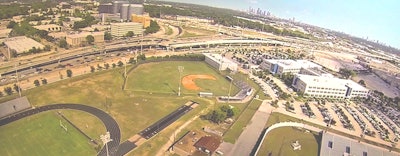
The Houston Independent School District is the largest school district in Texas, covering 333 square miles. It is the seventh-largest school district in the United States, providing interscholastic athletic programming for 43 middle schools and 24 high schools.
 Marmion Dambrino, CMAA, is athletic director for the Houston Independent School District
Marmion Dambrino, CMAA, is athletic director for the Houston Independent School District
Safety is one of the HISD's core values. As with any school district, regardless of size, it faces the challenge of dealing with the unknown in regard to safety and security at athletic venues. In our environment of multiple venues, multiple schools and more than 1,100 coaches, the task of attaining a standard implementation plan is compounded by sheer magnitude of size and scope.
My involvement in the development of the first edition of Best Practices for Interscholastic Athletics with the National Center for Spectator Sports Safety and Security (NCS4) was instrumental to the formation of a proactive plan for HISD. I saw the need to create a plan that reflected the local environment while encouraging an educationally sound atmosphere characterized by positive sportsmanship. Each athletic venue has an emergency plan that parallels the NCS4 Best Practices. Our simple approach to creating the HISD plan outlined venue assessment, planning with experts, training and coordination, and implementation and practice.
The most important aspect of assessment required us to identify any unique situations that existed at our varied venues. To accomplish this, we sought input from a variety of local experts, including personnel from the school district's law enforcement officials, legal counsel, risk management team and coaching staff, as well as the city's police, fire and emergency management departments. Building relationships with these groups played a critical role in the creation of a diligent and effective emergency-response plan. We all adhere to the motto, "If you see something, say something."
Plans on paper, discussion of plans, and meetings about plans are still simply plans that may avert legal culpability. Plans that are not practiced and communicated may lead to an assertion of negligence; therefore, coordination and training of all stakeholders is paramount. Key tasks on our checklist included student-body orientations and setting a tone with student-athletes, clear guidelines for game announcers, clear communication with parents and community members, and ongoing, proactive meetings with coaches. Without question, coaches play a critical role when implementation of an emergency response is needed.
Prepare — Respond — Recovery: This has become our mantra. If we have done a thorough job of planning and we have practiced to ensure understanding and efficiency, then transitioning back to our normal state will go smoothly.
I am indebted to our experts, especially the HISD Police Department, which has taken a lead role in the communication and training of stadium managers and event staff. However, it is the sum of all parts that will help us provide a safe and enjoyable experience at all of our athletic events. I encourage those who are in search of refining or developing their own plans to seek resources that are available from the NCS4 Best Practices as well as resources that are available through the National Interscholastic Athletic Administrators Association.
This article originally appeared in the Summer 2016 issue of Gameday Security
































